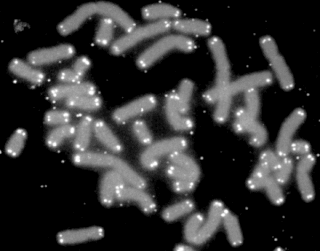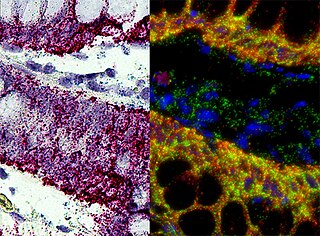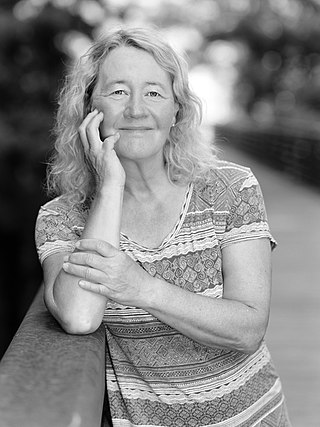Related Research Articles

A telomere is a region of repetitive nucleotide sequences associated with specialized proteins at the ends of linear chromosomes. Telomeres are a widespread genetic feature most commonly found in eukaryotes. In most, if not all species possessing them, they protect the terminal regions of chromosomal DNA from progressive degradation and ensure the integrity of linear chromosomes by preventing DNA repair systems from mistaking the very ends of the DNA strand for a double-strand break.
In genomics, DNA–DNA hybridization is a molecular biology technique that measures the degree of genetic similarity between pools of DNA sequences. It is usually used to determine the genetic distance between two organisms and has been used extensively in phylogeny and taxonomy.

Telomerase, also called terminal transferase, is a ribonucleoprotein that adds a species-dependent telomere repeat sequence to the 3' end of telomeres. A telomere is a region of repetitive sequences at each end of the chromosomes of most eukaryotes. Telomeres protect the end of the chromosome from DNA damage or from fusion with neighbouring chromosomes. The fruit fly Drosophila melanogaster lacks telomerase, but instead uses retrotransposons to maintain telomeres.

Cajal bodies (CBs) also coiled bodies, are spherical nuclear bodies of 0.3–1.0 µm in diameter found in the nucleus of proliferative cells like embryonic cells and tumor cells, or metabolically active cells like neurons. CBs are membrane-less organelles and largely consist of proteins and RNA. They were first reported by Santiago Ramón y Cajal in 1903, who called them nucleolar accessory bodies due to their association with the nucleoli in neuronal cells. They were rediscovered with the use of the electron microscope (EM) and named coiled bodies, according to their appearance as coiled threads on EM images, and later renamed after their discoverer. Research on CBs was accelerated after discovery and cloning of the marker protein p80/Coilin. CBs have been implicated in RNA-related metabolic processes such as the biogenesis, maturation and recycling of snRNPs, histone mRNA processing and telomere maintenance. CBs assemble RNA which is used by telomerase to add nucleotides to the ends of telomeres.

Elizabeth Helen Blackburn, is an Australian-American Nobel laureate who is the former president of the Salk Institute for Biological Studies. In 1984, Blackburn co-discovered telomerase, the enzyme that replenishes the telomere, with Carol W. Greider. For this work, she was awarded the 2009 Nobel Prize in Physiology or Medicine, sharing it with Carol W. Greider and Jack W. Szostak, becoming the first Australian woman Nobel laureate.

In situ hybridization (ISH) is a type of hybridization that uses a labeled complementary DNA, RNA or modified nucleic acids strand to localize a specific DNA or RNA sequence in a portion or section of tissue or if the tissue is small enough, in the entire tissue, in cells, and in circulating tumor cells (CTCs). This is distinct from immunohistochemistry, which usually localizes proteins in tissue sections.
Joseph Grafton Gall is an American cell biologist who is noted for studies revealing the details of chromosome structure and function. Gall's studies were greatly facilitated by his knowledge of many different organisms because he could select the most favorable organism to study when approaching a specific question about nuclear structure. He was awarded the 2006 Albert Lasker Special Achievement Award. He was also a co-recipient of the 2007 Louisa Gross Horwitz Prize from Columbia University. In 1983 he was honored with the highest recognition of the American Society for Cell Biology, the E. B. Wilson Medal. He had been elected to the American Academy of Arts and Sciences in 1968, the National Academy of Sciences in 1972, and the American Philosophical Society in 1989.

Carolyn Widney Greider is an American molecular biologist and Nobel laureate. She joined the University of California, Santa Cruz as a Distinguished Professor in the department of molecular, cell, and developmental biology in October 2020.

Nancy Hopkins, an American molecular biologist, is the Amgen, Inc. Professor of Biology at the Massachusetts Institute of Technology. She is a member of the National Academy of Sciences, the Institute of Medicine of the National Academy, and the American Academy of Arts and Sciences. She is known for her research identifying genes required for zebrafish development, and for her earlier research on gene expression in the bacterial virus, lambda, and on mouse RNA tumor viruses. She is also known for her work promoting equality of opportunity for women scientists in academia.
Virginia Zakian is the Harry C. Wiess Professor in the Life Sciences in the Department of Molecular Biology at Princeton University. She is the director of the Zakian Lab, which has done important research in topics such as telomere-binding protein, telomere recombination, and telomere position effects, at Princeton University. She is a fellow at the American Academy of Microbiology and the American Association for the Advancement of Science., and is an elected member of the National Academy of Sciences (2018). Zakian served as the chair of "Princeton's Task force on the Status of Women Faculty in the Natural Sciences and Engineering at Princeton" from 2001-2003, in 2003 Zakian became Princeton University's representative to Nine Universities, Gender Equity Analysis She was elected as a member of the American Academy of Arts and Sciences in 2019.
A Riboprobe, abbreviation of RNA probe, is a segment of labelled RNA that can be used to detect a target mRNA or DNA during in situ hybridization. RNA probes can be produced by in vitro transcription of cloned DNA inserted in a suitable plasmid downstream of a viral promoter. Some bacterial viruses code for their own RNA polymerases, which are highly specific for the viral promoters. Using these enzymes, labeled NTPs, and inserts inserted in both forward and reverse orientations, both sense and antisense riboprobes can be generated from a cloned gene.
Shelterin is a protein complex known to protect telomeres in many eukaryotes from DNA repair mechanisms, as well as to regulate telomerase activity. In mammals and other vertebrates, telomeric DNA consists of repeating double-stranded 5'-TTAGGG-3' (G-strand) sequences along with the 3'-AATCCC-5' (C-strand) complement, ending with a 50-400 nucleotide 3' (G-strand) overhang. Much of the final double-stranded portion of the telomere forms a T-loop (Telomere-loop) that is invaded by the 3' (G-strand) overhang to form a small D-loop (Displacement-loop).

Titia de Lange is the Director of the Anderson Center for Cancer Research, the Leon Hess professor and the head of Laboratory Cell Biology and Genetics at Rockefeller University.
In molecular biology, hybridization is a phenomenon in which single-stranded deoxyribonucleic acid (DNA) or ribonucleic acid (RNA) molecules anneal to complementary DNA or RNA. Though a double-stranded DNA sequence is generally stable under physiological conditions, changing these conditions in the laboratory will cause the molecules to separate into single strands. These strands are complementary to each other but may also be complementary to other sequences present in their surroundings. Lowering the surrounding temperature allows the single-stranded molecules to anneal or “hybridize” to each other.
Bryant Villeponteau is an American scientist, entrepreneur, and longevity expert who has worked in both academia and industry.

BioViva is an American biotechnology company, based in Bainbridge Island, Washington, researching treatments to interfere in the ageing process in humans.
Lisa Steiner is a professor of immunology in the department of biology at the Massachusetts Institute of Technology. When she arrived at MIT in 1967, she was the first woman faculty member in the department. Her research focuses on the evolution and development of the immune system, using zebrafish as a model organism.

Victoria Lundblad is an American geneticist whose work focuses on the genetic control of chromosome behavior in yeast. Many of her discoveries have concerned telomerase, the RNA-containing enzyme that completes the ends of chromosomes. She works at the Salk Institute in La Jolla, California.
Kathleen Collins is an American biophysicist and professor at the University of California, Berkeley. Her research considers telomerase RNA structure and telomere function. In 2020 she was elected a Fellow of the American Academy of Arts and Sciences.
Mary Armanios is Professor of Oncology, Genetic Medicine, Pathology and Molecular Biology, and Genetics at Johns Hopkins University School of Medicine and the Director of the Telomere Center at Johns Hopkins University. Her research focuses on the role of telomeres in disease.
References
- 1 2 3 "Mary-Lou Pardue". MIT Department of Biology. Retrieved 3 October 2015.
- 1 2 3 4 5 Wasserman, Elga (2002). The door in the dream conversations with eminent women in science (Reprinted in pbk. ed.). Washington, DC: Joseph Henry Press. pp. 97–102. ISBN 9780309086196.
- ↑ Mastony, Colleen (6 October 2009). "Female scientists' family tree traces roots to Yale professor". Chicago Tribune. Retrieved 2015-10-05.
- 1 2 3 "Pardue is first Magasanik Professor". MIT News. 8 November 1995. Retrieved 3 October 2015.
- ↑ Hopkins, Nancy (2010). Kaiser, David (ed.). Becoming MIT : moments of decision. Cambridge, Mass.: MIT Press. p. 188. ISBN 9780262113236.
- ↑ Pardue, Mary-Lou; Hopkins, Nancy; Potter, Mary C.; Ceyer, Sylvia (9 September 1999). "Moving on from discrimination at the Massachusetts Institute of Technology". Nature: 1–2. doi:10.1038/nature28068 . Retrieved 2015-10-04.
- ↑ Zernike, Kate (2023). The Exceptions: Nancy Hopkins, MIT, and the Fight for Women in Science. New York, NY: Scribner. ISBN 978-1-9821-3183-8.
- ↑ Evanko, Daniel (15 October 2007). "Nature Milestones: DNA Technologies". Nature Publishing Group. doi: 10.1038/nrg2247 . Retrieved 3 October 2015.
{{cite journal}}: Cite journal requires|journal=(help) - ↑ Pardue, ML; Gall, JG (October 1969). "Molecular hybridization of radioactive DNA to the DNA of cytological preparations". Proceedings of the National Academy of Sciences of the United States of America. 64 (2): 600–4. Bibcode:1969PNAS...64..600P. doi: 10.1073/pnas.64.2.600 . PMC 223386 . PMID 5261036.
- ↑ "Mary-Lou Pardue". www.nasonline.org. Retrieved 2019-11-01.
- 1 2 3 Pardue, Mary Lou; Gall, Joseph G. (1969-10-01). "Molecular Hybridization of Radioactive Dna to the Dna of Cytological Preparations". Proceedings of the National Academy of Sciences. 64 (2): 600–604. Bibcode:1969PNAS...64..600P. doi: 10.1073/pnas.64.2.600 . ISSN 0027-8424. PMC 223386 . PMID 5261036.